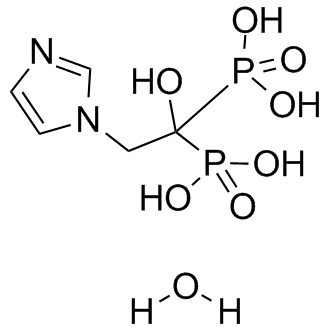| DC8951 |
4-NITROCATECHOL
|
|
| DC9005 |
(S)-(+)-ketoprofen
|
Dexketoprofen works by blocking the action of a substance in the body called cyclo-oxygenase. It belongs to a class of medicines called non-steroidal anti-inflammatory drugs (NSAIDs). |
| DC9043 |
Pramipexole 2HCL monohydrate
|
Pramipexole dihydrochloride hydrate is a selective dopamine D2-type receptor agonist, with Kis of 2.2 nM, 3.9 nM, 0.5 nM and 1.3 nM for D2-type receptor, D2, D3 and D4 receptors, respectively. Pramipexole dihydrochloride hydrate can be used for the resear |
| DC9236 |
Brequinar
|
Brequinar (DUP785) is a potent inhibitor of dihydroorotate dehydrogenase (DHODH) with an IC50 of 5.2 nM for human DHODH. Brequinar has potent activities against a broad spectrum of viruses. Brequinar also has an anti-SARS2 activity. |
| DC9212 |
Furafylline
|
Furafylline is a potent and selective inhibitor of human cytochrome P450IA2 with an IC50 of 0.07 μM. |
| DC9033 |
Zoledronic acid hydrate
|
Zoledronic acid monohydrate(CGP 42446; ZOL 446) is an activator of protein kinase C with apoptotic effects on multiple myeloma cell lines. It inhibited proliferation of human foetal osteoblastic cell line (hFOB) with an IC50 of 40 uM. |
| DCAPI1202 |
Vecuronium Bromide
|
Vecuronium Bromide |
| DC9003 |
Triamterene
|
Triamterene blocks epithelial Na+ channel (ENaC) in a voltage-dependent manner, which used as a mild diuretic. |
| DCAPI1555 |
Teicoplanin
|
Teicoplanin Complex is a complex of antibiotics produced by Actinoplanes teichomyceticus. Teicoplanin, the major component of Teicoplanin Complex, is a glycopeptide antibiotic structurally similar to Vancomycin (sc-204938) and Ristocetin (sc-202318). As a |
| DCAPI1552 |
streptomycin
|
Streptomycin (Agrept) is an effective antibiotic against M. tuberculosis, is used for the research of tuberculosis (TB). Streptomycin also is a bacteriocidal agent that can be used for the research of a number of bacterial infections. Streptomycin can bind strongly to nucleic acids, interferes and blocks protein synthesis while permitting continued RNA and DNA synthesis. Streptomycin, as a common antibiotic used in culture media, also is a blocker of stretch-activated and mechanosensitive ion channels in neurons and cardiac myocytes . |






















